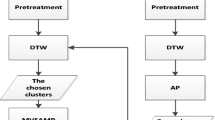Abstract
In order to achieve the better online gesture recognition rate, a multi-sensor fusion method is proposed in this chapter. After the dimension reduction and quantization, we first measure the performance of every single sensor in training phase and use this prior knowledge to determine the weight vector; then we do the fusion of multiple sensors according to the weight vector which indicates each sensor’s importance in recognition. The core algorithm we use for online gesture recognition is WarpingLCSS, which is demonstrated to be an efficient template matching method for gesture spotting. We do the experiments on the OPPORTUNITY Activity Recognition Datasets, and the results show that the recognition rate of multi-sensor fusion method achieves 61 %, which outperforms the single sensor’s performance about 11 %. This demonstrates that our proposed multi-sensor fusion method is efficient in improving the performance of online gesture recognition.
Access this chapter
Tax calculation will be finalised at checkout
Purchases are for personal use only
Similar content being viewed by others
References
Castellanos, J. A., Neira, J., & Tardós, J. D. (2001). Multisensor fusion for simultaneous localization and map building. IEEE Transactions on Robotics and Automation, 17(6), 908–914.
Luo, R. C., & Chang, C. C. (2012). Multisensor fusion and integration: A review on approaches and its applications in mechatronics. IEEE Transactions on Industrial Informatics, 8(1), 49–60.
Reddy, B. S., & Basir, O. A. (2010). Concept-based evidential reasoning for multimodal fusion in human–computer interaction. Applied Soft Computing, 10(2), 567–577.
Nguyen-Dinh, L. V., Roggen, D., Calatroni, A., Troster, G. (2012). Improving online gesture recognition with template matching methods in accelerometer data. In 2012 12th International Conference on Intelligent Systems Design and Applications (ISDA) (pp. 831–836). IEEE.
Hartmann, B., & Link, N. (2010). Gesture recognition with inertial sensors and optimized DTW prototypes. In 2010 I.E. International Conference on Systems Man and Cybernetics (SMC) (pp. 2102–2109). IEEE.
Stiefmeier, T., Roggen, D., Troster, G., Ogris, G., & Lukowicz, P. (2008). Wearable activity tracking in car manufacturing. IEEE Pervasive Computing, 7(2), 42.
Vlachos, M., Hadjieleftheriou, M., Gunopulos, D., & Keogh, E. (2003). Indexing multi-dimensional time-series with support for multiple distance measures. In Proceedings of the Ninth ACM SIGKDD International Conference on Knowledge Discovery and Data Mining (pp. 216–225). ACM.
Jeon, B., & Landgrebe, D. A. (1999). Decision fusion approach for multitemporal classification. IEEE Transactions on Geoscience and Remote Sensing, 37(3), 1227–1233.
Sakoe, H., & Chiba, S. (1978). Dynamic programming algorithm optimization for spoken word recognition. IEEE Transactions on Acoustics, Speech and Signal Processing, 26(1), 43–49.
Roggen, D., Calatroni, A., Rossi, M., Holleczek, T., Forster, K., Troster, G., et al. (2010) Collecting complex activity datasets in highly rich networked sensor environments. In 2010 Seventh International Conference on Networked Sensing Systems (INSS) (pp. 233–240). IEEE.
Author information
Authors and Affiliations
Corresponding author
Editor information
Editors and Affiliations
Rights and permissions
Copyright information
© 2014 Springer International Publishing Switzerland
About this paper
Cite this paper
Chen, C., Shen, H. (2014). Improving Online Gesture Recognition with WarpingLCSS by Multi-Sensor Fusion. In: Wong, W.E., Zhu, T. (eds) Computer Engineering and Networking. Lecture Notes in Electrical Engineering, vol 277. Springer, Cham. https://doi.org/10.1007/978-3-319-01766-2_64
Download citation
DOI: https://doi.org/10.1007/978-3-319-01766-2_64
Published:
Publisher Name: Springer, Cham
Print ISBN: 978-3-319-01765-5
Online ISBN: 978-3-319-01766-2
eBook Packages: EngineeringEngineering (R0)




